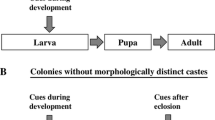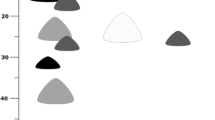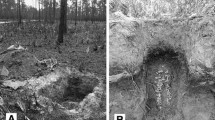Abstract
The allocation to growth, defense and reproduction varies in social insects within a species' life cycle and between species. A life cycle model (Oster and Wilson 1978) generally failed to predict caste allocation in small litter-nesting colonies of Neotropical Pheidole. Two of its assumptions were often invalid: food was unlikely to be limiting in four of five populations, and sexual biomass production accelerated, not decelerated, with colony size in three of five populations. One of five Pheidole populations studied had higher caste ratios (soldiers /workers) in reproductive colonies as predicted, and in no species did caste functions conform to predictions. We also adapted three models from plant defense theory to study between-species patterns of caste allocation. Among 12 litter Pheidole the amount of sterile biomass devoted to soldiers varied from 18 to 62%. Queen size, growth rate, and soldier investment positively covaried. Only one model, the cost of replacement hypothesis (McKey 1979), correctly predicted that species with costly female alates invest more in defense. The two hypotheses linking apparency to defense may also be valid if fast-growing colonies are more likely to attract the attention of predators.
Similar content being viewed by others
References
Andersen AN (1991) Parallels between ants and plants: implications for community ecology. In: Huxley CR, Cutler DF (ed) Ant-plant interactions. Oxford University Press, Oxford, pp 539–558
Beshers S, Traniello J (1994) The adaptiveness of worker demography in the attine ant Trachymyrmex septentrionalis. Ecology 75:763–775
Brian MV (1956) Group form and causes of working inefficiency in the ant Myrmica rubra. Physiol Zool 29:173–194
Byrne M (1994) Ecology of twig-dwelling ants in a wet lowland tropical forest. Biotropica 26:61–72
Calabi P, Nonacs P (1994) Changing colony growth rates in Camponotus floridanus as a behavioral response to conspecific presence (Hymenoptera: Formicidae). J Insect Behav 7:17–27
Calabi P, Traniello JFA (1989a) Behavioral flexibility in age castes of the ant Pheidole dentata. J Insect Behav 2:663–677
Calabi P, Traniello JFA (1989b) Social organization in the ant Pheidole dentata — physical and temporal caste ratios lack ecological correlates. Behav Ecol Sociobiol 24:69–78
Cole BJ (1984) Colony efficiency and the reproductivity effect in Leptothorax allardycei (Mann). Insectes Soc 31:403–407
Coley P, Bryant J, Chapin F (1985) Resource availability and plant antiherbivore defense. Science 230:895–899
Creighton WS (1966) The habits of Pheidole ridicula Wheeler with remarks on habit patterns in the genus Pheidole (Hymenoptera: Formicidae). Psyche 73:1–7
Dietrich W, Windsor D, Dunne T (1985) Geology, climate, and hydrology of Barro Colorado Island. In: Leigh EJ, Rand A, Windsor D (ed) The ecology of a tropical forest: seasonal rhythms and long-term changes. Smithsonian Institution Press, Washington DC, pp 21–46
Feener DH Jr. (1986) Alarm-recruitment behaviour in Pheidole militicida (Hymenoptera: Formicidae). Ecol Entomol 11: 67–74
Feeny P (1976) Plant apparency and chemical defense (Biochemical interactions between plants and insects, vol 10). Rec Adv Phytochem pp 1–40
Hamilton WD (1972) Altruism and related phenomena, mainly in social insects. Annu Rev Ecol Syst 3:193–232
Hasegawa E (1993) Nest defense and early production of major workers in the dimorphic ant Colobopsis nipponicus (Wheeler) (Hymenoptera: Formicidae). Behav Ecol Sociobiol 33:73–77
Haverty M (1977) The proportion of soldiers in termite colonies: a list and bibliography (Isoptera). Sociobiology 2:199–216
Herbers JM (1986) Nest site limitation and facultative polygyny in the ant Leptothorax longispinosus. Behav Ecol Sociobiol 19:115–122
Herbers JM (1990) Reproduction investment and allocation ratios for the ant Leptothorax longispinosus: sorting out the variation. Am Nat 136:178–208
Herms D, Mattson W (1992) The dilemma of plants: to grow or defend. Q Rev Biol 67:283–335
Holdridge L, Grenke W, Hatheway W, Liang T, Tosi J (1971) Forest environments in tropical life zones: a pilot study. Pergamon Press, New York
Hölldobler B, Wilson EO (1990) The ants. Belknap Press, Cambridge
Johnston AB, Wilson EO (1985) Correlates of variation in major/minor ratio in the ant, Pheidole dentata (Hymenoptera: Formicidae). Ann Entomol Soc Am 78:8–11
Kaspari M (1993) Removal of seeds from Neotropical frugivore droppings. Oecologia 95:81–99
Kaspari M, Vargo E (1995) Colony size as a buffer against seasonality: Bergmann's rule in social insects. Am Nat 145: 610–632
McKey D (1979) The distribution of secondary compounds within plants. In: Rosenthal G, Janzen D (ed) Herbivores: their interaction with secondary plant metabolites. Academic Press, New York, pp 55–133
Michener CD (1964) Reproductive efficiency in relation to colony size in hymenopterous societies. Insectes Soc 11:317–341
Nijhout HF, Wheeler DE (1982) Juvenile hormone and the physiological basis of insect polymorphisms. Q Rev Biol 57:109–133
Oster GF, Wilson EO (1978) Caste and ecology in the social insects (monographs in population biology 12). Princeton University Press, Princeton
Pamilo P (1991a) Evolution of colony characteristics in social insects. I. Sex allocation. Am Nat 137:83–107
Pamilo P (1991b) Evolution of colony characteristics in social insects. II. Number of reproductive individuals. Am Nat 138:412–433
Porter SD, Tschinkel WR (1985) Fire ant polymorphism: the ergonomics of brood production. Behav Ecol Sociobiol 16:323–336
Sanford RJ, Paaby P, Luvall J, Phillips E (1994) Climate, geomorphology, and aquatic systems. In: McDade L, Bawa K, Hespenheide H, Hartshorn G (ed) La Selva: ecology and natural history of a Neotropical rain forest. University of Chicago Press, Chicago, pp 19–33
Schmid-Hempel P (1992) Worker castes and adaptative demography. J Evol Biol 5:1–12
Schneirla TC (1957) A comparison of species and genera in the ant subfamily Dorylinae with respect to functional pattern. Insectes Soc 4:259–298
Schneirla TC (1961) The behavior and biology of certain Nearctic doryline ants — sexual broods and colony division in Neivamyrmex nigrescens. Z Tierpsychol 18:1–32
Tschinkel W (1993) Sociometry and sociogenesis of colonies of the fire ant Solenopsis invicta during one annual cycle. Ecol Monogr 63:425–457
Tschinkel WR (1988) Colony growth and the ontogeny of worker polymorphism in the fire ant, Solenopsis invicta. Behav Ecol Sociobiol 22:103–115
Vargo EL, Fletcher DJC (1987) Effect of queen number on the production of sexuals in natural populations of the fire ant, Solenopsis invicta. Physiol Entomol 12:109–116
Walker J, Stamps J (1986) A test of optimal caste ratio theory using the ant Camponotus (Colobopsis) impressus. Ecology 67: 1052–1062
Ward PS (1981) Ecology and life history of the Rhytidoponera impressa group (Hymenoptera: Formicidae). II. Colony origin, seasonal cycles, and reproduction Australia, New Caledonia. Psyche 1:109–126
Ward PS (1983) Genetic relatedness and colony organization in a species complex of ponerine ants. I Phenotypic and genotypic composition of colonies. Behav Ecol Sociobiol 12:285–299
Wheeler DE (1991) The developmental basis of worker caste polymorphism in ants. Am Nat 138:1218–1238
Whitford WG, Bryant M (1979) Behavior of a predator and its prey: the horned lizard (Phrynosoma cornutum) and harvester ants (Pogonomyrmex spp.). Ecology 60:686–694
Wilson EO (1953) The origin and evolution of polymorphism in ants. Q Rev Biol 28:136–156
Wilson EO (1968) The ergonomics of caste in the social insects. Am Nat 102:41–66
Wilson EO (1976) The organization of colony defense in the ant Pheidole dentata Mayr (Hymenoptera: Formicidae). Behav Ecol Sociobiol 1:63–81
Wilson EO (1983) Caste and division of labor in leafcutter ants (Hymenoptera: Formicidae: Atta). IV. Colony ontogeny of Atta cephalotes. Behav Ecol Sociobiol 14:55–60
Wilson EO (1984) The relation between caste ratios and division of labor in the ant genus Pheidole (Hymenoptera: Formicidae). Behav Ecol Sociobiol 16:89–98
Wilson EO, Hölldobler B (1985) Caste-specific techniques of defense in the polymorphic and Pheidole embolopyx (Hymenoptera: Formicidae). Insectes Soc 32:3–22
Yamaguchi T (1992) Interspecific interference for nest sites between Leptothorax congmus and Monomorium intrudens. Insectes Soc 39:117–127
Author information
Authors and Affiliations
Additional information
Communicated by P. Pamilo
Rights and permissions
About this article
Cite this article
Kaspari, M., Byrne, M.M. Caste allocation in litter Pheidole: lessons from plant defense theory. Behav Ecol Sociobiol 37, 255–263 (1995). https://doi.org/10.1007/BF00177405
Received:
Accepted:
Issue Date:
DOI: https://doi.org/10.1007/BF00177405




